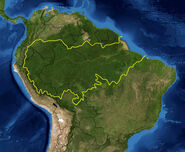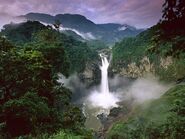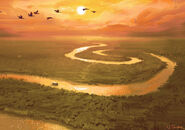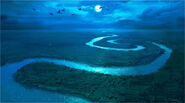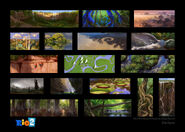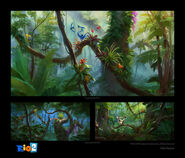(Editing a gallery) Tag: gallery |
(Editing a gallery) Tag: gallery |
||
| Line 87: | Line 87: | ||
Blu 100-Jewel 100 108.jpg |
Blu 100-Jewel 100 108.jpg |
||
BY WD8fCUAA8XeL.png large.png |
BY WD8fCUAA8XeL.png large.png |
||
| + | ..png |
||
</gallery> |
</gallery> |
||
Revision as of 00:45, 30 June 2016
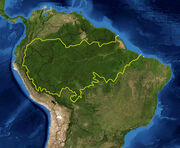
Outline of the Amazon rainforest

The Amazon landscape in Rio 2
The Amazon Rainforest (Portuguese: Floresta Amazônica or Amazônia; Spanish: Selva Amazónica, Amazonía or usually Amazonia; French: Forêt Amazonienne; Dutch: Amazoneregenwoud), also known in English as Amazonia or the Amazon Jungle, is a moist broadleaf forest that covers most of the Amazon Basin of South America. This basin encompasses 7,000,000 square kilometers (2,700,000 sq mi), of which 5,500,000 square kilometers (2,100,000 sq mi) are covered by the rainforest. This region includes territory belonging to nine nations. The majority of the forest is contained within Brazil, with 60% of the rainforest, followed by Peru with 13%, Colombia with 10%, and with minor amounts in Venezuela, Ecuador, Bolivia, Guyana, Suriname, and French Guiana. States or departments in four nations contain Amazonas in their names. The Amazon represents over half of the planet's remaining Rainforest, and it comprises the largest and most species-rich tract of tropical rainforest in the world, with an estimated 390 billion individual trees divided into 16,000 species.
Tapuyus and other tribes from South America. The women of the tribe fought alongside the men, as was the custom among the entire tribe. Orellana derived the name Amazonas from the mythical Amazons of Asia and Africa described by Herodotus and Diodorus in Greek legends.
In Rio 2, Blu, Jewel, and their chicks travel to the Amazon with Rafael, Nico, and Pedro tagging along to find the Spix's Macaw Tribe.
History
The rainforest likely formed during the Eocene era. It appeared following a global reduction of tropical temperatures when the Atlantic Ocean had widened sufficiently to provide a warm, moist climate to the Amazon basin. The rain forest has been in existence for at least 55,000,000 years, and most of the region remained free of savanna-type biomes at least until the current ice age, when the climate was drier and savanna more widespread.
Following the Cretaceous–Paleogene extinction event, the extinction of the dinosaurs and the wetter climate may have allowed the tropical rainforest to spread out across the continent. From 65–34 Mya, the rainforest extended as far south as 45°. Climate fluctuations during the last 34 million years have allowed savanna regions to expand into the tropics. During the Oligocene, for example, the rainforest spanned a relatively narrow band that lay mostly above latitude 15°N. It expanded again during the Middle Miocene, then retracted to a mostly inland formation at the last glacial maximum. However, the rainforest still managed to thrive during these glacial periods, allowing for the survival and evolution of a broad diversity of species.
During the mid-Eocene, it is believed that the drainage basin of the Amazon was split along the middle of the continent by the Purus Arch. Water on the eastern side flowed toward the Atlantic, while to the west water flowed toward the Pacific across the Amazonas Basin. As the Andes Mountains rose, however, a large basin was created that enclosed a lake; now known as the Solimões Basin. Within the last 5–10 million years, this accumulating water broke through the Purus Arch, joining the easterly flow toward the Atlantic.
There is evidence that there have been significant changes in Amazon rainforest vegetation over the last 21,000 years through the Last Glacial Maximum (LGM) and subsequent deglaciation. Analyses of sediment deposits from Amazon basin paleolakes and from the Amazon Fan indicate that rainfall in the basin during the LGM was lower than for the present, and this was almost certainly associated with reduced moist tropical vegetation cover in the basin. There is debate, however, over how extensive this reduction was. Some scientists argue that the rainforest was reduced to small, isolated refugia separated by open forest and grassland; other scientists argue that the rainforest remained largely intact but extended less far to the north, south, and east than is seen today. This debate has proved difficult to resolve because the practical limitations of working in the rainforest mean that data sampling is biased away from the center of the Amazon basin, and both explanations are reasonably well supported by the available data.
More than half of the dust needed for fertilizing the Amazon rainforest is provided by the Bodélé depression in Sahara. Up to 50 million tonnes per year are windblown across the Atlantic Ocean.
The New 7 Wonders of Nature
The Amazon rainforest and River, along with other 6 locations (Jeju Island of South Korea, Halong Bay of Vietnam, Iguazú / Iguaçu Falls (National Park) of Argentina/Brazil, Puerto Princesa Underground River of Philippines, Komodo Island (National Park) of Indonesia and Table Mountain (National Park) of South Africa), have been officially announced as the New 7 Wonders of Nature on November 11th, 2011 in Zurich, Switzerland. Total voting set a new record for New7Wonders: over 500 million votes were cast – 500% more than in our first campaign to elect the man-made New7Wonders of the World. [1]
Amazon River
The Amazon River (Spanish and Portuguese: Amazonas) in South America is generally regarded as the second longest river in the world and is by far the largest by waterflow with an average discharge of about 209,000 cubic meters per second (7,381,000 cu ft/s), greater than the next seven largest rivers combined (not including Madeira and Rio Negro, which are tributaries of the Amazon).
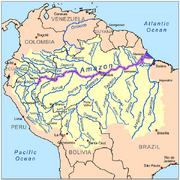
Map showing the Amazon drainage basin
The Amazon, which has the largest drainage basin in the world, about 7,050,000 square kilometers (2,720,000 sq mi), accounts for approximately one-fifth of the world's total river flow. The river would have the biggest drainage basin in the world even just counting Brazil, which it enters with only one-fifth of the volume that will finally be discharged into the Atlantic.
In its upper stretches, above the confluence of the Rio Negro, the Amazon is called Solimões in Brazil; however, in Peru, Colombia and Ecuador, as well as the rest of the Spanish-speaking world, the river is generally called the Amazon downstream from the confluence of the Marañón and Ucayali rivers in Peru. The Ucayali-Apurímac river system is considered the main source of the Amazon, with its main headstream being the Carhuasanta glacial stream flowing off the Nevado Mismi mountain.
Biodiversity
Wet tropical forests are the most species-rich biome, and tropical forests in the Americas are consistently more species rich than the wet forests in Africa and Asia. As the largest tract of tropical rainforest in the Americas, the Amazonian rainforests have unparalleled biodiversity. One in ten known species in the world lives in the Amazon Rainforest. This constitutes the largest collection of living plants and animal species in the world.
The region is home to about 2.5 million insect species, tens of thousands of plants, and some 2,000 birds and mammals. To date, at least 40,000 plant species, 2,200 fishes, 1,294 birds, 427 mammals, 428 amphibians, and 378 reptiles have been scientifically classified in the region. One in five of all the bird species in the world live in the rainforests of the Amazon, and one in five of the fish species live in Amazonian rivers and streams. Scientists have described between 96,660 and 128,843 invertebrate species in Brazil alone.
The biodiversity of plant species is the highest on Earth with some experts estimating that one square kilometer (247 acres) may contain more than a thousand types of trees and thousands of species of other higher plants. According to a 2001 study, a quarter square kilometer (62 acres) of Ecuadorian rainforest supports more than 1,100 tree species.
One square kilometer (247 acres) of Amazon rainforest can contain about 90,790 tonnes of living plants. The average plant biomass is estimated at 356 ± 47 tonnes per hectare. To date, an estimated 438,000 species of plants of economic and social interest have been registered in the region with many more remaining to be discovered or catalogued.
The green leaf area of plants and trees in the rainforest varies by about 25% as a result of seasonal changes. Leaves expand during the dry season when sunlight is at a maximum, then undergo abscission in the cloudy wet season. These changes provide a balance of carbon between photosynthesis and respiration.
The rainforest contains several species that can pose a hazard. Among the largest predatory creatures are the black caiman, jaguar, cougar, and anaconda. In the river, electric eels can produce an electric shock that can stun or kill, while piranha are known to bite and injure humans. Various species of poison dart frogs secrete lipophilic alkaloid toxins through their flesh. There are also numerous parasites and disease vectors. Vampire bats dwell in the rainforest and can spread the rabies virus. Malaria, yellow fever and Dengue fever can also be contracted in the Amazon region.
Conservation
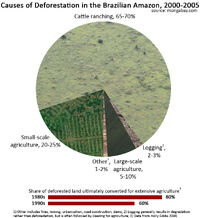
Out-dated data. Today, it is estimated that cattle ranching is responsible for 80%. Due to the alarming increase in meat consumption and therefore, production in the past years.
Deforestation has been going on for domestic and foreign companies in Brazil, especially in the U.S. and several European countries, being 91% of the amazon rainforest has been cut down in the last 40 years. Conservation groups around the world are concerned about deforestation, which happens to be somewhat part of Rio 2.
70% of the area that used to be covered by the forest and 91% of the now deforested area since 1970, is used to feed livestock. The meat industry is the main problem that destroys the wild life in Brazil and around the world. The vast fields of soy production and other beans are also very prejudicial to the fertility of the soil. About 80% of all soy produced in the Amazon is used as cattle feed.
The forest keeps being gradated for the rising demand of animal products, which leads to a larger need of area to plant and keep the livestock. As so, Brazil is one of the world's larger meat exporting country, since many countries have no space to rise their own cattle. Brazil is also a leading country on exporting soy and other beans used as cattle feed.


